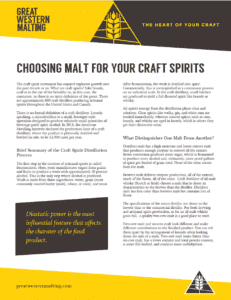
CHOOSING MALT FOR YOUR CRAFT SPIRITS
By Great Western MaltingThe craft spirit movement has enjoyed explosive growth over the past decade or so. What are craft spirits? Like beauty, craft is in the eye of the beholder or, in this case, the consumer, as there is no strict definition of the genre. There are approximately 600 craft distillers producing artisanal spirits throughout the United States and Canada.
There is no formal definition of a craft distillery. Loosely speaking, a microdistillery is a small, boutique-style operation designed to produce relatively small quantities of beverage-grade spirit alcohol. In 2013, the American Distilling Institute declared the production limit of a craft distillery, where the product is physically distilled and bottled onsite, to be 52,000 cases per year.
Brief Summary of the Craft Spirit Distillation Process
Click here to download a print-friendly version of this article!
What Distinguishes One Malt From Another?
Factors Affecting the Choice of Malt
| Brewer | Distiller | |
| Moisture % | Max 4.5 | Max 6.5 |
| Protein % | Max 12.5 | Min 13 |
| DBFG % | 80 | 77 |
| Diastatic Power | 110-130 | Min 240 |
Malted barley is one of three key ingredients in craft spirits. Its purpose is to release sugars from the starches present in the cereal for the yeast to ferment into alcohol. The four most important characteristics in a craft malted whisky are its moisture and protein contents, yield of fermentable sugars, and diastatic power. Distillers will want to consider the malt specifications when choosing malt.


